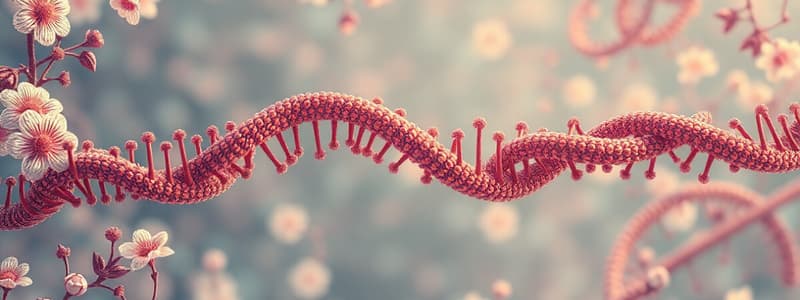Podcast
Questions and Answers
What is the primary function of transfer RNA (tRNA) during translation?
What is the primary function of transfer RNA (tRNA) during translation?
- To transcribe DNA into RNA
- To produce mRNA from amino acids
- To synthesize ribosomes
- To translate codons into amino acids (correct)
Which component is essential for the charging of tRNA?
Which component is essential for the charging of tRNA?
- DNA polymerase
- Messenger RNA (mRNA)
- Aminoacyl tRNA Synthase (correct)
- Ribosomal RNA (rRNA)
How many nucleotides compose a single tRNA molecule?
How many nucleotides compose a single tRNA molecule?
- ~80 nucleotides (correct)
- 50 nucleotides
- 120 nucleotides
- 30 nucleotides
What provides the chemical energy required for translation?
What provides the chemical energy required for translation?
What does the anticodon on tRNA do during translation?
What does the anticodon on tRNA do during translation?
Which statement about the genetic code is true?
Which statement about the genetic code is true?
What are codons composed of?
What are codons composed of?
What happens to the mRNA after its nucleotides are translated into a polypeptide?
What happens to the mRNA after its nucleotides are translated into a polypeptide?
What is the role of ribosomes in translation?
What is the role of ribosomes in translation?
The genetic code consists of single nucleotide codons.
The genetic code consists of single nucleotide codons.
What is the function of aminoacyl tRNA synthetase?
What is the function of aminoacyl tRNA synthetase?
The process of converting mRNA codons into polypeptides is known as __________.
The process of converting mRNA codons into polypeptides is known as __________.
Match the following components involved in translation with their primary roles:
Match the following components involved in translation with their primary roles:
How many nucleotides are there in a typical tRNA molecule?
How many nucleotides are there in a typical tRNA molecule?
TRNA molecules have the same structure for every amino acid.
TRNA molecules have the same structure for every amino acid.
Describe the relationship between codons and anticodons.
Describe the relationship between codons and anticodons.
During transcription, the DNA strand is transcribed into __________.
During transcription, the DNA strand is transcribed into __________.
Match the following terms with their definitions:
Match the following terms with their definitions:
Flashcards are hidden until you start studying
Study Notes
Prokaryotic vs Eukaryotic Transcription
- Transcription differs between Prokaryotic and Eukaryotic cells
- In prokaryotic cells, transcription and translation occur simultaneously in the cytoplasm
- In eukaryotic cells, transcription occurs in the nucleus, and translation occurs in the cytoplasm
RNA Processing
- RNA processing occurs before nuclear exit in eukaryotic cells
- Processing includes capping, splicing, and tailing
- These processes protect the mRNA and help it be recognized during translation
Translation: Players
- Translation requires several key components
- mRNA provides the code to construct the polypeptide chain
- Ribosomes serve as a platform for translation and facilitate peptide bond formation
- Transfer RNA (tRNA) carries amino acids to the ribosome, matching them to specific codons on mRNA
- Enzymes facilitate the process, and chemical energy, such as ATP, is needed
Translation: Nucleotides to Amino Acids
- The genetic code, also known as the codon, is a series of three-base codons that translate nucleotide sequences in RNA to amino acid sequences
- Each three-base codon in DNA is transcribed into a complementary three-base codon in RNA
- These RNA codons are then translated into amino acids, forming a polypeptide chain
Transfer RNA (tRNA)
- tRNA acts as a translator, converting nucleic acid codons into amino acid sequences
- tRNA molecules perform two essential functions: they pick up the correct amino acid and recognize the corresponding codons in mRNA using an anticodon
- The unique structure of tRNA molecules enables them to perform both tasks, due to their distinct amino acid attachment site and anticodon
- The anticodon triplet is complementary to a codon triplet on mRNA, allowing the tRNA to recognize a specific codon during translation
- tRNA molecules are single RNA strands consisting of ~80 nucleotides
- Each tRNA molecule has a specific site where one specific amino acid attaches
- The process of attaching an amino acid to tRNA is called "charging" and is carried out by Aminoacyl tRNA Synthase
- While all tRNA molecules are similar, there are slightly different versions for each of the 20 amino acids.
Prokaryotic vs Eukaryotic Transcription
- Prokaryotic cells do not have a membrane-bound nucleus, so transcription and translation occur in the cytoplasm simultaneously.
- Eukaryotic cells have a nucleus, so transcription occurs in the nucleus and translation occurs in the cytoplasm.
RNA Processing in Eukaryotes
- RNA processing occurs after transcription and before mRNA exits the nucleus.
- RNA processing involves the addition of a 5' cap and a 3' poly-A tail, as well as splicing out introns.
Translation Players
- Translation is the process of converting mRNA into protein.
- Ingredients for translation:
- mRNA
- Ribosomes
- Transfer RNA (tRNA)
- Enzymes
- ATP (energy source)
Genetic Code
- The genetic code is a set of rules that translate nucleotide sequences in mRNA into amino acid sequences.
- Each three-base codon in mRNA corresponds to a specific amino acid.
- The genetic code is universal, meaning it is the same in all living organisms.
Transfer RNA (tRNA)
- tRNA acts as an adapter molecule that reads mRNA codons and delivers the corresponding amino acid to the ribosome.
- tRNA structure:
- Single-stranded RNA molecule
- Contains an anticodon that base pairs with the mRNA codon
- Has an amino acid attachment site at the other end.
Aminoacyl tRNA Synthase
- Aminoacyl tRNA synthase is an enzyme that attaches the correct amino acid to the tRNA molecule.
- This process is called charging the tRNA.
Studying That Suits You
Use AI to generate personalized quizzes and flashcards to suit your learning preferences.




